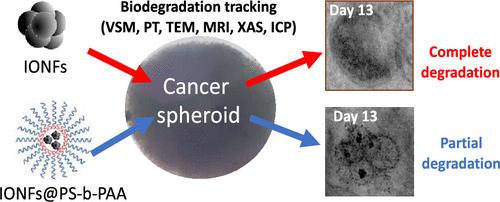当前位置:
X-MOL 学术
›
ACS Appl. Mater. Interfaces
›
论文详情
Our official English website, www.x-mol.net, welcomes your feedback! (Note: you will need to create a separate account there.)
Biodegradation by Cancer Cells of Magnetite Nanoflowers with and without Encapsulation in PS-b-PAA Block Copolymer Micelles
ACS Applied Materials & Interfaces ( IF 8.3 ) Pub Date : 2024-06-29 , DOI: 10.1021/acsami.4c08727 Emilia Benassai 1 , Niéli Daffé 2 , Elif Aygun 3 , Audrey Geeverding 4 , Emine Ulku Saritas 3, 5 , Claire Wilhelm 6 , Ali Abou-Hassan 1, 7
ACS Applied Materials & Interfaces ( IF 8.3 ) Pub Date : 2024-06-29 , DOI: 10.1021/acsami.4c08727 Emilia Benassai 1 , Niéli Daffé 2 , Elif Aygun 3 , Audrey Geeverding 4 , Emine Ulku Saritas 3, 5 , Claire Wilhelm 6 , Ali Abou-Hassan 1, 7
Affiliation

|
Magnetomicelles were produced by the self-assembly of magnetite iron oxide nanoflowers and the amphiphilic poly(styrene)-b-poly(acrylic acid) block copolymer to deliver a multifunctional theranostic agent. Their bioprocessing by cancer cells was investigated in a three-dimensional spheroid model over a 13-day period and compared with nonencapsulated magnetic nanoflowers. A degradation process was identified and monitored at various scales, exploiting different physicochemical fingerprints. At a collective level, measurements were conducted using magnetic, photothermal, and magnetic resonance imaging techniques. At the nanoscale, transmission electron microscopy was employed to identify the morphological integrity of the structures, and X-ray absorption spectroscopy was used to analyze the degradation at the crystalline phase and chemical levels. All of these measurements converge to demonstrate that the encapsulation of magnetic nanoparticles in micelles effectively mitigates their degradation compared to individual nonencapsulated magnetic nanoflowers. This protective effect consequently resulted in better maintenance of their therapeutic photothermal potential. The structural degradation of magnetomicelles occurred through the formation of an oxidized iron phase in ferritin from the magnetic nanoparticles, leaving behind empty spherical polymeric ghost shells. These results underscore the significance of encapsulation of iron oxides in micelles in preserving nanomaterial integrity and regulating degradation, even under challenging physicochemical conditions within cancer cells.
中文翻译:

癌细胞对有或没有封装在 PS-b-PAA 嵌段共聚物胶束中的磁铁矿纳米花的生物降解
磁胶束是通过磁铁矿氧化铁纳米花和两亲性聚(苯乙烯)-b-聚(丙烯酸)嵌段共聚物的自组装产生的,以提供多功能治疗诊断剂。在 13 天的时间内,在三维球体模型中研究了癌细胞对它们的生物处理,并与非封装的磁性纳米花进行了比较。利用不同的物理化学指纹,在不同的尺度上识别和监测降解过程。在集体层面上,测量是使用磁、光热和磁共振成像技术进行的。在纳米尺度上,使用透射电子显微镜来识别结构的形态完整性,并使用X射线吸收光谱来分析晶相和化学水平的降解。所有这些测量结果都表明,与单个未封装的磁性纳米花相比,将磁性纳米粒子封装在胶束中可以有效减轻其降解。这种保护作用因此可以更好地维持其治疗光热潜力。磁胶束的结构降解是通过磁性纳米粒子在铁蛋白中形成氧化铁相而发生的,留下空的球形聚合物鬼壳。这些结果强调了将氧化铁封装在胶束中对于保持纳米材料完整性和调节降解的重要性,即使在癌细胞内具有挑战性的物理化学条件下也是如此。
更新日期:2024-06-29
中文翻译:

癌细胞对有或没有封装在 PS-b-PAA 嵌段共聚物胶束中的磁铁矿纳米花的生物降解
磁胶束是通过磁铁矿氧化铁纳米花和两亲性聚(苯乙烯)-b-聚(丙烯酸)嵌段共聚物的自组装产生的,以提供多功能治疗诊断剂。在 13 天的时间内,在三维球体模型中研究了癌细胞对它们的生物处理,并与非封装的磁性纳米花进行了比较。利用不同的物理化学指纹,在不同的尺度上识别和监测降解过程。在集体层面上,测量是使用磁、光热和磁共振成像技术进行的。在纳米尺度上,使用透射电子显微镜来识别结构的形态完整性,并使用X射线吸收光谱来分析晶相和化学水平的降解。所有这些测量结果都表明,与单个未封装的磁性纳米花相比,将磁性纳米粒子封装在胶束中可以有效减轻其降解。这种保护作用因此可以更好地维持其治疗光热潜力。磁胶束的结构降解是通过磁性纳米粒子在铁蛋白中形成氧化铁相而发生的,留下空的球形聚合物鬼壳。这些结果强调了将氧化铁封装在胶束中对于保持纳米材料完整性和调节降解的重要性,即使在癌细胞内具有挑战性的物理化学条件下也是如此。











































 京公网安备 11010802027423号
京公网安备 11010802027423号